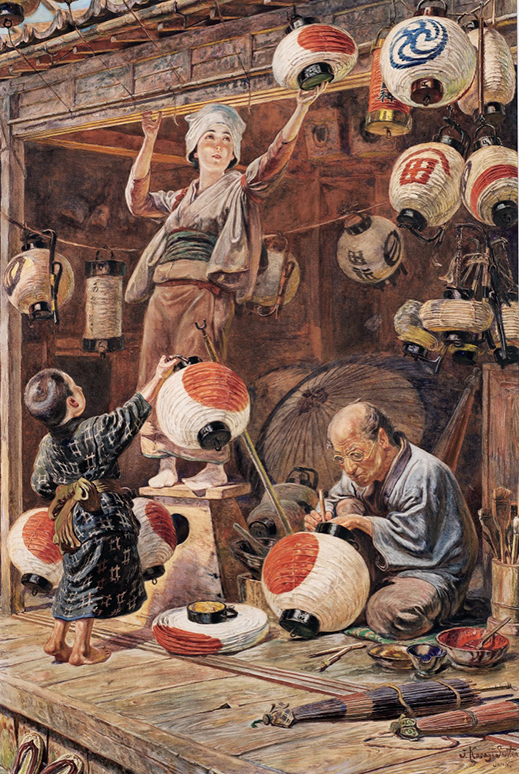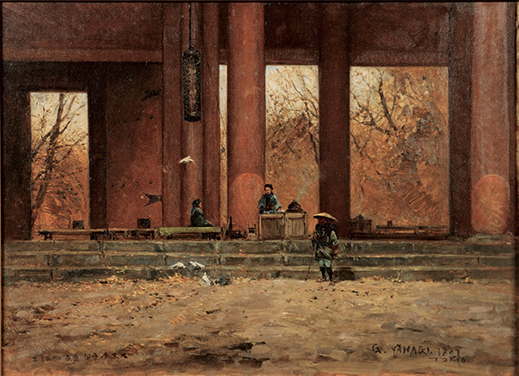| |
|
Here and There introduces art, artists, galleries, museums, and other cultural facilities around Japan that non-Japanese readers and first-time visitors may find of particular interest.
|
|
 |
|
|
 |
 |
The Yoga of Yoga: How Western-Style Painting Gained a Foothold in Meiji Japan
Alan Gleason |
 |
Bunsai Ioki, Peddler Visiting a Farmhouse, year unknown, watercolor on paper |
The early Meiji era, which began in 1868 with the abolition of the Tokugawa Shogunate and the official restoration of the emperor as the supreme power in the land, is a period that never ceases to fascinate. Though often treated as a time of breakneck modernization, the process was anything but smooth. For one thing, the Meiji "Restoration" was more precisely a coup d'etat aimed at toppling the shogun, followed by several years of civil war before the royalists consolidated their control. Forces for and against change continued to vie for dominance, and both sides could be ruthless in pushing their agendas.
Polarization between pro- and anti-Western factions (insofar as modernization was practically synonymous with Westernization) extended beyond politics into every corner of Japanese culture. Art was no exception. Young artists and ukiyo-e veterans alike eagerly turned to novel Western media like oil and watercolor and techniques like perspective and chiaroscuro. Many studied under the foreign artists who beat a path to Japan once its ports were opened for trade. Others ventured abroad to study Western painting and returned to teach what they had learned. There was an art-world backlash, too, epitomized by the Nihonga movement -- an attempt by conservatives to codify the traditions of indigenous "Japanese-style" painting to combat the growing influence of Yoga, or "Western-style" painting.
Georges Ferdinand Bigot, The Kitchen of the Kikuya Hotel in Shuzenji, Izu, 1887, oil on board |
An exhibition currently on view at the Fuchu Art Museum introduces the generation of early-Meiji Japanese artists who adopted Western realism as their muse and applied it to paintings, primarily in watercolor, of landscapes and scenes of daily life. Featured, too, are the non-Japanese artists -- mostly British and American -- who spent time in Japan in the late 1800s. Most made a living teaching art while painting their own depictions of Japan, motivated at least in part by a love of what they saw and a desire to convey it to people in their home countries. The show also includes works by a subsequent generation of Japanese artists who attempted to reconcile the Western techniques they had acquired with calls for a more distinctly "Japanese" approach to realist painting. Interestingly, those exhortations came not only from Nihonga proponents, but from Western artists in Japan as well.
The rather curious English title of the show, We're Back "Benevolent Meiji", is a translation of Tadaima Yasashiki Meiji, which might sound more idiomatic as "Gentle Meiji Returns." Curator Hidetaka Shiga explains that these works share a warmth that is missing from early photographs of Meiji citizens with their stiff, stoic poses. The subjects of these paintings appear lively, good-natured, and blessed with sometimes comedic eccentricities. The landscapes are gentle, too -- lyrically composed of soft colors and contours that owe much to the Barbizon school or the Impressionists in their renderings of a peaceful, pastoral, pre-industrial Japan. The impression they give is of a country populated by happy folk working the fields, engaged in their crafts, or strolling village streets with nary a samurai nor a smokestack in sight. One is tempted to think that the artists were pandering to their market of souvenir-seeking tourists and people abroad eager to catch a glimpse of this exotic, newly accessible land. Surely they understood that idyllic views of the premodern Japan of the not-so-distant past would sell better than those of bustling downtown Tokyo.
|
 |
|
|
|
Charles Wirgman, Woman with a Parasol, 1876, watercolor on paper
|
But in point of fact, the Industrial Revolution did not reach very far outside of a few major cities in Japan before the turn of the century. Just a few miles west of the Ginza, on the Musashi Plain where the Fuchu Art Museum is located today, rural life went on much as it had in the days of the shogun. Even more than their Japanese disciples, visiting Westerners were captivated by these bucolic scenes and devoted much time to sketching them for consumption back home. Leading the way was the British journalist and illustrator Charles Wirgman, best known perhaps for his satirical magazine Japan Punch, which he launched soon after arriving in Yokohama in 1861. An accomplished artist, Wirgman spent the rest of his life in Japan and turned out a copious number of sketches and paintings of ordinary places and people. His wife Kane often modeled for him, as in the portrait Woman with a Parasol shown here.
Wirgman also taught painting, and is credited with sowing the seeds of Yoga through his students, not a few of them featured in the Fuchu show. He was followed to Japan by a veritable flood of British painters, some of them quite prominent. Sir Alfred East, already known for his Barbizon-influenced landscapes, spent six months in the country in 1888 and made a splash upon his return home with an exhibition of over 100 Japan-themed works. East also lectured on art while in Japan, and his admonition that domestic artists must express more individuality and poetic feeling in their paintings is credited with spurring Yoga acolytes to produce more original, less derivative, work. It also gave them encouragement at a time when Western-style painters were suffering from the slings and arrows of pro-Nihonga critics and the reputation of Yoga was at low ebb. East's exhortation was viewed by some as a jab at Nihonga's obsession with adherence to "traditional" methods and materials. In any event, Yoga began to enjoy a resurgence soon afterward.
 |
|
Alfred East, Drying Umbrellas after the Rain, year unknown, watercolor on paper |
Few of the Japanese artists who pioneered the Yoga genre are household names in their own country, and some are virtual unknowns. One reason is that so many sold their works to foreign tourists who sailed away with them. Indeed, the present exhibition owes its existence to one man's efforts to acquire and repatriate as much of this diaspora of art as possible through auctions in the United States and England. The collector, Mitsumasa Takano (b. 1939), is a Nagoya-born businessman who has been collecting Meiji-era art for four decades -- inspired, he says, by the discovery of one such painting at an auction in New York when he was studying at a nearby university. The Takano Collection now boasts some 700 paintings, several hundred of which can be viewed in this show. Complementing offerings by 45 Japanese artists associated with Yoga are a nearly equal number by Wirgman, East, and 30 other European and American artists who painted and taught in Japan. Whether they left the country as souvenirs or as part of an artist's portfolio, all of these works vanished from Japan and would not be on view in Fuchu today if it were not for Takano's persistence -- hence the "We're Back!" of the title.
 |
|
 |
|
|
|
|
Jirokichi Kasagi, Lantern Shop, year unknown, watercolor on paper
|
|
Jirokichi Kasagi, Newspaper Delivery Man, year unknown, watercolor on paper |
One of Takano's most stunning discoveries is a hitherto unknown artist, Jirokichi Kasagi (1870-1923), who excelled at vibrant watercolor portrayals of people in rural settings engaged in everyday pursuits -- farming, fishing, making and selling various handicrafts. What stands out is the ultrarealistic, and occasionally hilarious, manner in which he depicts his subjects. Whether it is a man assiduously weaving a fishing net, a lantern-maker and his family all working together, or a newspaper boy running pell-mell down a country road with an armful of deliveries, the faces of people in Kasagi's paintings brim with life and character, a dramatic departure from the stock visages of ukiyo-e courtesans and actors. If anything, Kasagi's subjects are more idiosyncratic, and in a painterly sense more "Western," than those in the works of Wirgman, East, et al. It is interesting to compare, for example, the face of the lantern-maker's wife, or those of the farm girls in Kasagi's titular painting, with Mrs. Wirgman in Woman with a Parasol.
 |
|
 |
|
|
|
|
Jirokichi Kasagi, Farm Girls, year unknown, watercolor on paper
|
|
Katsuzo Takahashi, Portrait of a Girl, 1905, oil on board |
To my subjective eye, though, Katsuzo Takahashi's Portrait of a Girl offers the most realistically rendered face of the three of them. Takahashi (1860-1917) was among the earliest of the Meiji painters to train overseas. Traveling to the U.S. in 1885, he studied realist painting and became known for his Impressionistic seascapes and landscapes. Upon returning to Japan in the 1890s, Takahashi and his fellow expats were appalled by the anti-Yoga sentiment stirred up by the Nihongaists in the intervening decade, and sought to restore Yoga's reputation with an infusion of realism and an emphasis on plein-air work. They also leaned toward the use of watercolor rather than oil, and it was not long before their efforts triggered a watercolor boom in Japan that has never really subsided.
Curator Shiga observes that the preference for watercolor made perfect sense in light of the affinity between its materials and methods and those of the traditional genre of sansuiga -- landscapes painted with sumi ink on paper. It was also a medium that lent itself to quick sketches outdoors, sparking a surge in the output and sales of doro-sansui, "roadside landscapes." Shiga further argues that the use of watercolor not only fostered acceptance of Yoga as a legitimately Japanese art form, but also facilitated the infusion of the painters' work with the individual flavor and emotional lyricism that East and others had found lacking in Japanese art. The Fuchu Art Museum show testifies to the success achieved -- often in the face of fierce opposition emblematic of the broader social tensions of the Meiji era -- by Japanese artists determined to make "Western-style" painting their own.
 |
|
Genkichi Yanagi (Takahashi), Shiba Zojo-ji Temple, 1887, oil on canvas |
All images are courtesy of the Fuchu Art Museum.
|
|
|
| |
 |
Alan Gleason
Alan Gleason is a translator, editor and writer based in Tokyo, where he has lived for over 30 years. Since 2006 he has edited artscape Japan and written the Here and There column, as well as translating the Picks reviews. He also edits and translates works on Japanese architecture, music, and theater. |
|
|
|
|
|
|
|
|
|
 |
|